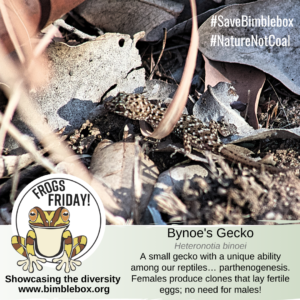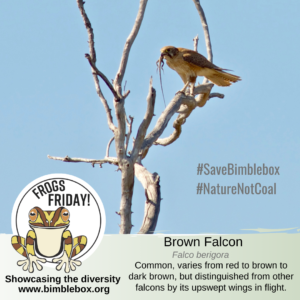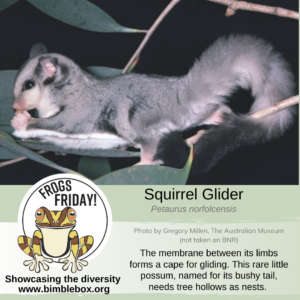Here we share the thoughts of Ian Hoch, carer at Bimblebox, as triggered by the Frogs Friday posts (included) on the plants and animals he observes so closely. Poetic as well as practical and philosophic, they contribute much to our understanding of life on Bimblebox.
~~~~~~~~~~~~~~
Weeding, you’ll meet these tiny pearls
and you’re weeding so as to meet them,
take repose on tender knees and recompense
for blistered hands and face.
Suddenly, revealed in Sonya’s lens,
not one, but orbits of a thousand flowers,
fanned from nascent olive star
forming inflorescence of ivory
with frills of teeny weeny sepals,
pussy toe whiskers to tickle your daisy.
Shame, no longer in carpets
but rare and endangered.
Ruti’s loss is ours, these are the jewels we lose.
And you’re weeding so the unborn can meet them.
~~~~~~~~~~~~~~
Eastern Dead Finish…
One provincial anecdote has it that the first zealous squatters to follow the trigger-happy Thomas Mitchell’s untiring footsteps the length of the picturesque Barcoo found themselves bushwhacked in an infuriating unrelenting maze of tanglewood scrub. At day and wit’s end, amongst other unspeakable oaths they swore at the gods above – “This mongrel stuff is the dead finish!”.
Quite plausibly the name and the story has stuck.
However, a more obvious and believable explanation for the tree’s common name would come via its tendency to shed soft and dainty confetti leaves at the first breath of drought and to thereafter project a dead finish of unyielding spikes to scratch and snag tender sunburnt skin, no matter how carefully you proceed.
Either way, common names are often cause to reflect on a short lived and short sighted past.
In the eternal emptiness brought about by the loss of so much indigenous language and knowledge we “settlers” are prone to remake history with slapdash unimaginative names for even the most provocative and enigmatic plants and places.
A thousand Sandy Creeks and nondescript ironbarks and gum trees bear testament to the lacklustre mindset of the very pragmatic “heroic pioneer”, who ironically was to meet his match with this particular prophetic namesake species.
Often growing in a thicket and like many other “underground” trees, a quarter-acre grove of Dead Finish is inevitably all the one multiplex individual, and many an ambitious latter-day pastoralist has found ample reason to curse its tenacity and ability to sucker prolifically from disturbed roots.
Upended abruptly and sent sprawling by bulldozer and chain, and soon after reduced to charred stumps in the razed earth inferno that follows, the resilient Archidendropsis is far from finished. Like war orphans, offspring regrow with a vengeance and renewed purpose.
Locked now in a rudimentary battle, man employs more brutal and drastic means.
Designed to erase Australia in one Herculean sweep, a jumbo’s wing of solid steel is drawn at walking pace through the spongy archaic soil by a gigantic bellowing 150 tonne, 1500 horse-powered iron-tracked Caterpillar.
With a low growl, belching thick black soot from twin stacks, the landed Titanic pries apart the desert sands at depth and the much desired immediate effect is the death knell to all living beings.
In one pass, a clean sheet, a year zero, a restart and makeover with just the chosen few.
And two years on, it would seem the pastoralist has prevailed as the greatest force this land has ever known.
And yet.. and yet, what’s that over there… a strangely familiar, reassuring yet disturbing sight. A waist-high stand of straggly Dead Finish regrowth once again making claim on the heaved and fractured ground.
So despite, rather than in spite of all that she has endured, and almost as if an act of kindness or mercy, Dead Finish makes amends.
Fence builder and wood turner rejoice with echoes of gate posts weathered to cast iron hardness and artful salad bowls whittled to expose lilacs and violets making opal look drab.
Fairy wren, weebill and zebra finch regain nesting haven in dappled shady seclusion.
Mountain wanderrie, silkyheads and purple love grass recover their preferred growth medium.
And many generations on, at the tail end of the protracted eco wars, we no longer curse or condemn what we don’t understand.
Instead we give thanks, and plead the gods to hark and suspend another deeper sleeping legend – an aboriginal prophecy – when this old fella die, it’s dead finish for country.
~~~~~~~~~~~~~~
If only…
Can you feel the solid earth bear your weight and daylight infiltrate weary eyelids?
Can you hear above the swishing airwaves, a discordant electric chatter?
Have dawn eyes, slowly yawn, to discern old mountain coolabah towering clean and lean, where entangled in droopy-leafed canopy a dozen disparate stars sparkle like shattered glass.
And on the palest possible pink ceiling, darting iridescent woodswallows swarm in multitudes, soaring, circling, swirling, hovering, floating – these little birds take you with them instantly, flying for the heck of it, for the sheer thrill, for pure desire, like the surfie lost to endorphins.
Individuals on a shaky twig, twitching with excitement, catching breath – surfer on the sand, then launching again headlong into the throng, arching up, rolling askew, defying gravity.
Ever daring, never colliding, not the budgie’s retentive choreographed synchronicity… this the antithesis, freewheeling with gay abandon, casting doubt and shame to the wind.
The classic arrowhead design in Leonardo’s muse, making aerobatics acrobatic, but graceful, energetic yet effortless, these little birdies take you away and you indulge completely in their antics, soaring high above your daily work and worry for that instructive wayward hour.
For you also take their lesson and see them return to tree top and ground, to sticks and mortar, to security and defence of lifestyle and home.
They teach us how to live, how to share the joy and toil of living, how to make exercise leisure and take pleasure gratuitously, and take time out to balance the time taken in keeping house so assiduously.
A forlorn but sincere wish for us all, certain to make the world a better place …if only we could stretch the wings.
~~~~~~~~~~~~~~
Geckoes
There’s a garden variety, and the clandestine living jewels secreted in the unkempt bush, so cryptic and camouflaged they materialise only as deserving reward for keen-eyed jackaroo back bent to cutting wood.
On just another dreary sunny afternoon, a mundane task is suddenly made heavenly…
Crouched on all fours, wishing for magnifier to bring clarity to colours and patterns woven into delicate velvet lovingly depicted on broad canvas of indigenous art, born here of a creature so slight, soft, shy and gentle that one questions its existence in this setting pitiless and harsh, until, surprised at reaction to an irresistible advance, it is seen, so daring and agile.
Our desert: land of subtlety and paradox, arcane bounty and beauty not in your face but unobtrusive underfoot.
We may never notice the glories we lose in pursuit of the wealth we never gain.
~~~~~~~~~~~~~~
The perfect chaotic soil system of the Desert Uplands
This stunning image taken by Greg Harm of the Brown Falcon with its small dragon lizard catch could be the emblem of Bimblebox, as it’s a familiar sight in this land of raptors and reptiles. Both flourish here; one, you might think, at the expense of the other, until you realise… there’s aplenty and a place for all.
That spartan aerial triad of tree, lizard and bird contrasts starkly with the clutter and bustle directly beneath. In wet season these arid woodlands will rival rainforest for terrestrial activity and diversity. While nothing jumps out at you, closer attention divulges a hive of enterprise.
Bugs and grubs and spiders galore, hoppers and butterflies and beetles swarm in a dense variegated carpet of vegetation, and lizards of all sorts harvest the full range of arthropods and also the ubiquitous nevertire termites whose astonishing microbial digestion extracts the last skerricks of energy from long dead grass and bark. With their relentless 24/7 gnawing, they’ve eaten half my life’s share of wood work, and fire the other half; any creature adopting a white ant diet in OZ is on a winner…!
In looking down and skyward again some bygone high school biology springs to mind, with vague understated phrases like “food chain” and “web of life” and you begin to get a sense of their true meaning and full function… of how everything in nature fits chaotically together, of how it self-regulates and perpetuates, of how tree, lizard and bird are but three of a conglomeration of organisms and physical forces that create, transport and recycle nutrients otherwise lacking in these timeworn and depleted sandy soils.
Unlike heavy cracking clays of the open “downs” to the east and west, the desert uplands (akin to rainforest) are dependent on organic matter and activity for replenishment. One way to view fertility in the light porous soils of this region is literally – “you’re looking at it” – tied up in the biota.
A simple proof is to grab a handful and shake it in a glass of water. Happily on top you’ll find a finger width of debris, then a thin slither of clay particles, and the rest… beach sand. Any gardener worth his broccoli knows you need to feed sandy soil for it to retain water and release minerals. To manage sustainably we’d need to think of this place like a big organic garden, complete with compost regime and crop rotation.
Of course we can slash and burn and concertina eons of growth and decomposition into a couple of human lifespans.
We can go one jump further. Call the living earth overburden, strip it altogether, excavate the black substrate accumulated over millions of years from those same ecological processes.
How extremely convenient for us, in each case, to separate the components of immediate utility and disregard the rest. Both practices are proven to be short-sighted extravagance with disastrous consequences. But still they persist.
On Bimblebox we’re resolved to retain falcon and dragon, as indicative of healthy environment, already hard pressed in cattle country.
You’ll find neither in the bottom of a coal pit.
~~~~~~~~~~~~~~
The Cat Wars
Enigmatic, this little fella; don’t think he’s supposed to be here. I found one dead up on the netting and pretty sure it was Sonya (Duus) who sent it away to be identified as a Squirrel. Didn’t have the white tip which distinguishes him from the Sugar Glider.
From what I read and understand, these more delicate and vulnerable mammals were doomed from the day Cook claimed possession and liberated his pigs on Cape York and explains why Nature Conservancy and Bush Heritage go to all the trouble with exclusion fencing.
I’m as sick of finding bird feathers around water troughs as I am tired of shooting and trapping cats. All my efforts only create a temporary void for another tabby. After 150 years, predator and prey must have established an equilibrium of sorts with the native species either cat- savvy or exterminated, and populations of both being sustained by availability of food and refuge.
I don’t know what to do about it but do know (as child of a cat lover mum) that top of menu for moggies is small birds and gliders. The rarer the tastier. A fluffy tail usually the only reminder of the delicacy that was.
I have to fence roos and rabbits from this native plant nursery to tackle the same problem in the floral realm. The sweetest species don’t get a chance to reproduce. Especially those already on the edge of their range and resilience.
You might say hardly makes any difference, we’ve never really noticed their presence nor lament their loss and that’s true until you’re holding a Sugar baby or watching them glide in the moonlight between tall ghost gums, and it’s then you know what you’re missing.
I’ve seen 3 or 4 other elusive marsupials that I don’t think are listed on those sham EIS. And whether they’re listed or not is hardly the point. As the designate implies – we’re a nature refuge. The idea is to maintain habitat for wildlife for it’s own sake, not just for the things we happen to notice.
At the same time we wouldn’t kid ourselves these ephemeral or vulnerable species will be here for much longer. Or not without our concerted efforts to cater for them.
Huge counter influences are at play out there now (at sister property Kerand) in the wake of the regional scale, near complete transition to full-on production. We’re in that shake down period and in 20 years we’ll know what’s been able to cope, and so far it doesn’t look too promising. At Kerand, it’s likely to have been 90% reduction in 50 years. I think that’s called decimation.
Can’t see how we can avoid the same from happening here. Or not at this rate. Not without ridding the place (or select parts) of pigs and cats and rabbits, buffel and secca. Ironically and cruelly those highly adaptive foreign species, unburdened by co-evolutionary checks and balances, are just way too strong for the unique niche and specialist natives.
It’s been that way the world over for centuries. Just so happens the tail end of the colonial frontier has swept through the central west in our lifetime. The eco dynamics are in continuous flux, goes on by the minute – and much we never know. Foxes and deer and goats and hares and cane toads have all come and gone from here but pigs and cats and rabbits found a perfect home and pick the eyes out of the local smorgasbord.
As I understand, cats are at their most populous and gigantuan right across the arid zone. They’ve evolved into pumas and devastate what’s left of all those wee dainty bopping bundles of fluff that live out there in the spinifex.
We might yet get to appreciate the bunny and the tabby, and not torment ourselves with reminders of squirrel gliders.






